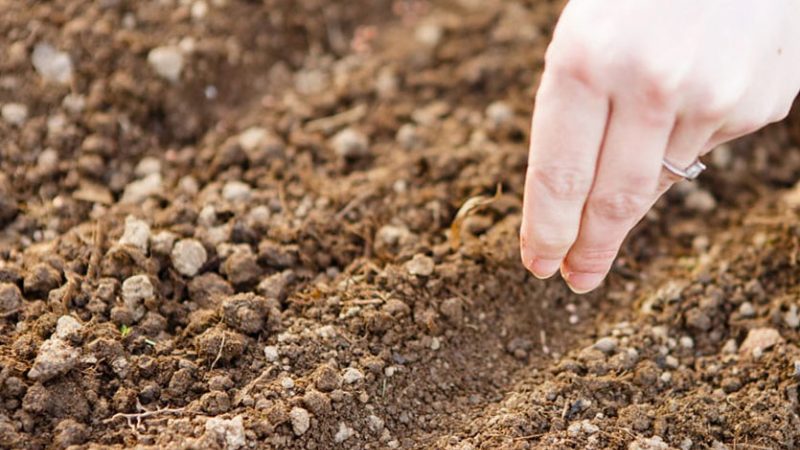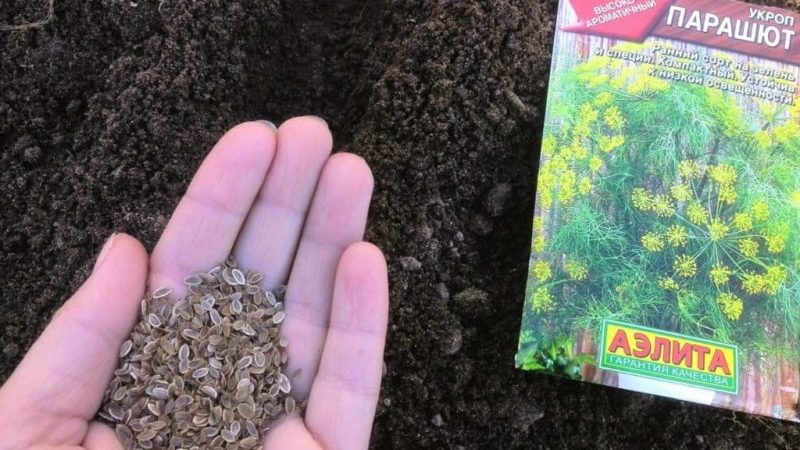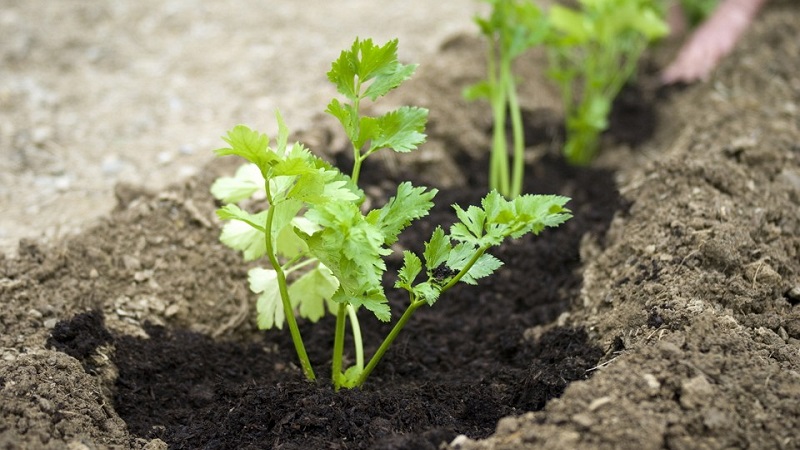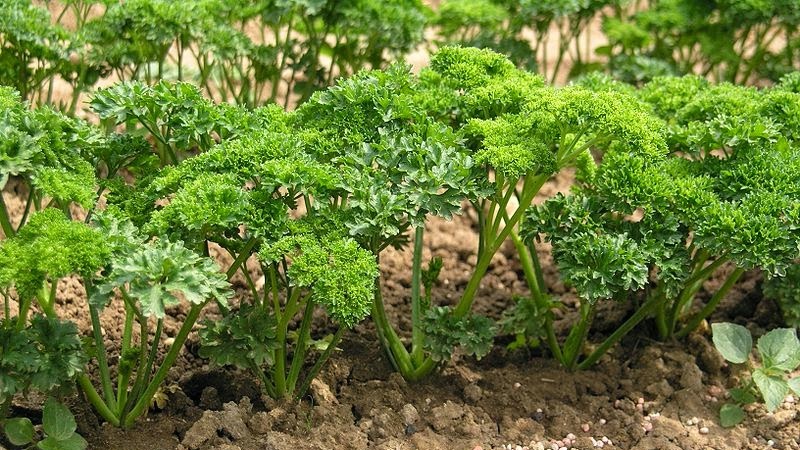How to properly plant parsley and dill before winter, and when is it best to do it
Spicy parsley and dill are traditionally added to many dishes. Planting crops from September to November allows you to get vitamin and aromatic greens in early spring. When and how to plant parsley and dill in the fall before winter, we will consider in this article.
The content of the article
Features of planting in the cold season
Is it possible to sow parsley and dill before winter? Sowing of these crops in autumn is possible due to their cold resistance: the seeds undergo natural hardening in the soil and in the spring they please with friendly shoots.
The result is healthy, disease- and frost-resistant spices a month earlier than traditional planting in spring.
Seat selection
Plants are planted in open, sunny areas. Although dill and parsley tolerate shade well, they grow slightly elongated and less saturated green in the absence of sunlight. The taste and benefits are preserved.
Ideal crop precursors: potatoes, tomatoes, cabbage, onions, zucchini and cucumbers.
Grasses prefer neutral or slightly acidic soil with a light texture.
Preparing the beds

At the end of October, humus is added to the beds at the rate of 5 kg per 1 m², 20–30 g of superphosphate and potassium are added. Nitrogen fertilizers are not applied before winter.
They make grooves and cover them with protective material so that the soil is not washed away by rain.
Before sowing, the covering material is removed, the grooves are sprinkled with sand. After planting, the bed is sprinkled with peat, humus or compost. The main thing is that the soil is light and in the spring the seeds germinate without difficulty.
Important! Optimal weather conditions for planting dill and parsley: night temperature - -2 ... -3 ° C, daytime - 0 ... + 5 ° C, dry, windless days.
If prolonged rains are expected, the sown bed is re-covered and left so until dry or not very wet cold weather sets in.
Seed preparation
Experienced gardeners prefer their seed to store-bought. To obtain it, several strong and healthy bushes are kept in beds with herbs during the season. Parsley is covered with mulch for the winter (a two-year culture), and dill is harvested in the fall.
After the umbrella flowering, small seeds appear on the plants, which ripen for 120 days. Before cutting, paper or gauze is spread under the bushes to collect crumbled material. The umbrellas are cut neatly. Sort out the seeds, removing diseased or unripe seeds. Dry and store them until planting at a temperature of + 5 ° C in a well-ventilated place.
Reference. The seeds are not soaked before the autumn sowing, otherwise they will germinate ahead of time and die.
To increase germination, planting material is pre-coated with:
- A nutrient mixture is prepared from non-acidic peat, humus and dry mullein (6: 3: 1).
- 15 g of superphosphate are added to 1 kg of the mixture.
- Before planting, seeds are poured into the jar and the nutrient composition is added. Shake everything well.
- If the material was coated in advance, it is dried for 2-3 hours.
Such inlaid seeds endure cold weather, and in spring they give amicable shoots.
Landing scheme
30-40% of seeds are added to the usual seeding rate of crops, since not everyone will survive the frost.
In order for the planting material to evenly warm up during the day, grooves 3–5 cm deep are pulled from north to south.
Distance between them:
- for leaf parsley - 10–12 cm;
- for curly hair - 8-10 cm;
- for dill - 10 cm.
Root parsley is planted at a distance of 2–4 cm, 1 seed each.
Dill seeds are planted in a garden bed and without grooves, in a fan. To do this, they are mixed with sand and scattered on a prepared place. Sprinkle with peat or humus on top.
Use this method before snow falls so that it covers the garden. In the spring, melt water draws seeds into the ground, they quickly swell and germinate. Dill takes root well, it turns out fluffy. With this method of planting, less seeds are required, and the yield is higher.
Varieties of parsley and dill for winter planting
Best suited for winter sowing crops with early and medium ripening.
Dill

When dill throws out the umbrella, it loses its juicy fragrant greenery, its stem becomes tough. Therefore, the main criterion for choosing a variety is the late formation of the umbrella.
Dill can be bush or green.
The best bush varieties:
- Patterns. Leaves up to 1 m in height grow slowly, from the very root. Productivity - 50 g of greens from 1 bush. The greens are cut off 2 months after the young growth appears. The plant is rich in vitamin C and is resistant to fungal diseases.
- Gourmet. The variety has low lush bushes up to 20 cm high. The greens are cut after 1.5 months. The dark green leaves are fragrant. Dill is not susceptible to disease.
- Mammoth. After 40–42 days, it gives strong bushes with late shoots. Productivity when harvested for herbs - 1.7 kg / m², for spices - 3 kg / m². The variety is resistant to adverse weather conditions, diseases and pests.
- Bushy. Sprawling, up to 1.5 m high bushes take up a lot of space, but ripen in 40 days (79 days - for spices). The leaves are soft with a persistent aroma.
For greens:
- Further - a high-yielding industrial variety, giving up to 2.5 kg of greenery per 1 m². Resistant to diseases and pests.
- Max. Compact, 15 cm high, the leaves resemble a diamond. The first crop is harvested 1.5 months after sowing. During the season, they receive 30-40 greens from 1 bush.
- Kutuzovsky. The greens are cut 40–45 days after sowing. The leaves are large, up to 20 cm, with a delicate taste and spicy aroma. 1.6 kg are collected for greens from 1 m², and 1.8 kg for spices.
Parsley

Distinguish between leaf and root parsley.
Among the leaf varieties popular:
- Italian giant... Abundant leaf mass (30–60 cm high) recovers quickly after cutting. Up to 25 leaves are obtained from 1 bush.
- Ordinary leaf. The leaves are flat carved, the stem grows to 90 cm. Parsley ripens 2-3 months after sowing.
- Esmeralda - mid-season variety with a quirky curly foliage... Average yield - 0.8-1.2 kg / m².
In root parsley, a cone-shaped root vegetable is valued, which is used in cooking and medicine. The leaves of these varieties are tough and less aromatic. They are not cut often, otherwise the plant will not have enough strength to develop a full-fledged root crop.
The best varieties:
- Russian size. Cold-resistant parsley produces sweetish roots up to 30 cm in length.
- Eagle. Technical ripeness reaches 110–125 days after emergence. Root crops are smooth, sweet, weigh up to 140 g.
- Bordovician. With a deep digging of the beds, the roots reach 35 cm in length. The crop is harvested in 90-100 days.
When to sow parsley and dill before winter
In any region, when landing, they are guided by the current weather: daytime temperature should tend to 0 ° C, night temperature - to + 2 ... + 3 ° C.
If heavy rains have begun, it is better to postpone the landing. If the timing does not allow this, the beds are covered with polyethylene from an excess of moisture.
Average winter time planting parsley and dill by regions of Russia:
- in the middle lane - 3rd decade of October - 1st decade of November;
- in the Urals - all October;
- in Siberia - the end of September;
- in the southern regions - November, December.
Lunar calendar

Knowing the phases of the moon and the constellation in which it is located helps to choose the optimal time for planting plants.
General rules for determining the optimal lunar date in any year:
- on the growing moon, they sow and transplant everything that grows above the earth;
- roots and legumes are planted on the descending line.
Depending on the effect on the plants, the constellations in which the satellite is located are divided into:
- Fertile: Cancer (the most fertile), Libra, Scorpio, Capricorn, Pisces, Taurus. When the Moon is in one of these signs, the sowing will give a rich harvest, but it will be poorly stored.
- Infertile: Sagittarius, Virgo, Gemini. The low yield is compensated by the long storage of the fruit.
- Infertile: Aquarius, Leo, Aries. Sowing under these signs will not bear fruit, the harvested crop is carefully stored.

It is better to plant parsley and dill on the growing moon when it passes one of the fertile signs of the zodiac. Parsley for root crops is sown on the waning moon in a fertile sign.
No plants are planted during the new and full moon. You can dig up the ground, destroy pests, remove dry branches.
Attention! Knowledge of the lunar calendar is no substitute for following the rules cultivation culture.
Conclusion
Agrotechnical measures for winter sowing of herbs do not require special knowledge and equipment. It is enough to choose a suitable place on the site, properly prepare it and the seeds, planting them according to a certain scheme. When the main recommendations are followed, vitamin and tasty greens are harvested in early spring.